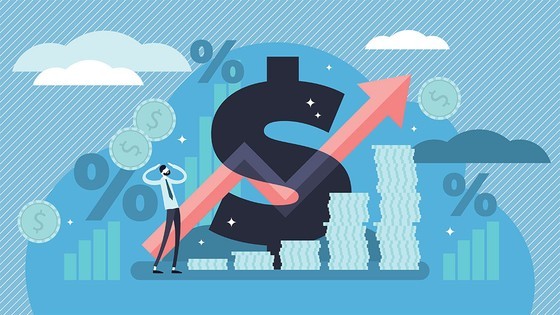 |
The interest rates dropped in a number of economic sectors from 5.5 percent per year to 5.0 percent per year. The immediate effect led to the stock market exploding by 2.1 percentage points in the session on March 15.
Favorable factors
The pressure of high-interest rates was removed partly when commercial banks reduced the rate at the beginning of March. However, the move to reduce the operating interest rate by the State Bank of Vietnam has officially sent a strong message and dispelled doubts that the interest rate reduction of commercial banks was a compulsion.
Until the State Bank of Vietnam reduced the operating interest rate, there were still many concerns that the FED pressure to raise interest rates at the end of March 2023 would prevent the reduction of domestic interest rates. However, many recent favorable factors have created an opportunity to reduce interest rates. Firstly, the exchange rate has remained very stable from the end of February 2023 to the middle of March. The US dollar reached a three-month peak in early March. The weakening of the US dollar continues to support the State Bank of Vietnam in buying foreign currencies, which means it is injecting Vietnamese dong for more liquidity. Meanwhile, the credit growth rate in the first two months of the year was only about 0.77 percent compared to 2.52 percent in the same period in 2022.
Secondly, another event that occurred was three US banks collapsing simultaneously last week, which forced the US Government to cover for all deposits to restore confidence. At the same time, inflation in February showed signs of slowing down as expected. This caused market expectations to turn 180 degrees, from worrying that the FED would return to a 0.5 percent rate hike this March after the hawkish message at the hearing, to predicting that the FED will raise only 0.25 percent, even without raising interest rates anymore. This is a situation where bad news is good news for the stock market. If the FED accepts slowing down, the pressure on the US dollar will be lower.
Thirdly, foreign capital flow into Vietnam is still rather strong. Even the recent round of net buying of foreign investors on the stock market shows that this capital flow shift will not lead to a worrisome situation. Since the beginning of March until now, foreign investors have still maintained a net buying of more than VND1,800 bln on HoSE. During this time, both domestic and foreign Exchange Traded Funds (ETFs) still netted VND1,274 bln, of which foreign funds amounted to VND460.6 bln. From the beginning of 2023 until now, the scale of foreign capital net buying has reached VND4,962 bln.
For the market, the operating interest rate of the State Bank of Vietnam is a clear directive. What is more interesting is the state of the ceiling deposit interest rate as well as the actual lending interest rate. Bank commitment to the lower interest rate is good news, but access to affordable loans is more crucial. The deposit rate has decreased, but there is still some doubt in the actual interest rate.
Stock boom
The stock market rallied more than 2 percent soon after the news of the reduction of the interest rate was announced, showing that they were anxiously awaiting a good sign at this time. From the peak at the end of January 2023 until now, the market has been mostly falling or moving sideways, as support factors were absent. However,
whether the policy sign is strong enough to promote a new growth trend in the stock market or if it will take another turn altogether is to be seen.
The first barrier is too many mutant factors. The current excitement comes from the timing assumption that the State Bank of Vietnam has begun to reverse its policy from constricted to easing. The external context is also assumed that the FED will slow down the rate hike and maybe even stop increasing from the next meeting in May.
These factors can completely change in the next few weeks, and the FED can still maintain the intensity of interest rate hikes stronger than market expectations. Then the assumption will be different again. The market still needs time to get ready for a more solid signal. Even after reducing the interest rate, the State Bank of Vietnam still emphasized that it was not subjective to increasing inflationary pressure in the context that inflation in the first two months of 2023 had increased close to the level of 4.5 percent.
The second barrier is the downtrend in the stock market which is not easy to reverse in just a few days or weeks, as it takes a long time to consolidate and accumulate thereby giving clear signals. For instance, the increase of about 3.7 percent of the VN Index from the beginning of March until now does not make much sense if you look at the medium and long-term picture as the market is still in a downtrend. However, the January peak remains intact.
The third barrier indicates the whole first quarter of 2023 with a high-interest rate, orders decreasing, and business results of the year's first quarter still unknown. The general meeting of shareholders in March will reveal more business prospects from the perspective of business leaders, rather than from conjecture and analysis. The market needs at least a specific number to estimate a clearer outlook.
The fourth barrier is the cash flow as the market is clearly weak in purchasing power right now. A large amount of money in the market has been channeled into savings. The deposit interest rate peaked around the end of December 2022 and remained for the whole month of January 2023. Assuming that investors prefer to take refuge in the short term with the best interest rate of six months, it will take until the first week of May 2023 for this amount of capital to be released. Besides, May will be the time to decide whether the FED has the ability to reverse its policy or not.
























